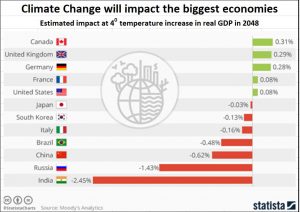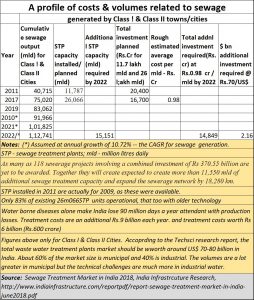https://www.moneycontrol.com/news/india/opinion-petty-graft-could-sabotage-water-and-waste-management-and-even-the-pms-biggest-schemes-4236081.html
Water #10
(Other articles in this series are given below)
Water and waste management are crucial to the the PM’s biggest schemes, but they are being sabotaged
RN Bhaskar — July 23, 2019
There are three schemes of Prime minister Narendra Modi which could actually transform much of India. And all of them relate to water and waste management — in ways that cannot be imagined. Yet crafty bureaucrats and sticky fingers will do their best to ensure that the linkages are not fixed, and the PM’s three schemes remain incomplete, and at times even embarrassments. .
Three gems
One is the Swachh Bharat Mission or SBM which talks of a spend of Rs.133,000 crore over five years for rural India alone. This translates into Rs.26,600 crore a year (www.thehindubusinessline.com/opinion/financing-swachh-bharat/article7089855.ece). Swachh Bharat is about building toilets and preventing open defecation. No other prime minister has come out boldly in favour of such a scheme – which is today a mission.
The other is Ujjwal Bharat which saw its subsidy bill soar to Rs 45,000 crore last year (https://www.financialexpress.com/market/commodities/over-20000-crore-shortfall-seen-in-fuel-subsidy-outlay-for-fy20/1499642/ ). Ujjwal Bharat aims at proving a gas connection to every home, especially in rural areas. This would ensure that women do not have to breathe in the fumes caused by burning firewood. It would also help reduce deforestation. In fact, according to Economic Survey 2016-17 Volume 2, respiratory ailments alone are believed to be responsible for 115,000 deaths and a cost of US$ 4.6 billion each year.
The third is Ayushman Bharat which had a Rs,62,659.12 crore allocation in the recently tabled budget (https://www.livemint.com/budget/news/not-highlighted-in-budget-speech-ayushman-bharat-fssai-get-major-chunk-of-fund-1562334924875.html) . This refers to the world’s largest medical insurance programme for the needy at highly subsidised premium rates. Each household gets a cover of Rs.5 lakh per annum. When it reaches out to its self-imposed target of 50 crore people or 10 crore households, the insurance cover could touch a mind-boggling Rs.5,000 lakh crore (https://www.moneycontrol.com/news/business/opinion-ayushman-bharat-is-a-great-concept-but-where-are-the-doctors-2851461.html)
Water and waste management is the key
Binding all of these together is water and waste management which, according to World Bank’s estimates for India’s total water and sanitation sector, is worth $420 million, with an annual growth rate of 18 per cent. But these figures could be modest, as the total cost could exceed US$80 billion. Even the growth rate could exceed 18% per annum.
When confronted with such numbers, the first question to ask is whether this expenditure is worth spending. And answer is an unequivocal yes.
First, as surveys of the World Health Organisation (WHO) have shown (http://geografie-uoradea.ro/Reviste/Anale/Art/2015-1/8.AUOG_678_Hemant.pdf), water (and food) borne diseases account for an estimated 4.1% of the total daily global burden of disease, and cause about 1.8 million human deaths annually. Almost 88% of that burden is attributable to unsafe water supply, sanitation and hygiene.
When it comes to India, “around 37.7 million Indians are affected by waterborne diseases annually; 1.5 million children are estimated to die of diarrhea alone and 73 million working days are lost due to waterborne disease each year. The resulting economic burden is estimated at $600 million a year. The problem of chemical contamination is also prevalent in India with 1, 95,813 habitations in the country are affected by poor water quality.”
McKenzie and Ray (2004) state that poor water quality, sanitation, and hygiene result in the loss of 30.5 million disabilities adjusted life years in India.
 “According to one estimate (Parikh, 2004), India lost about Rs 366 billion (over US$50 billion), which account for about 3.95 per cent of the GDP, due to ill effects of water pollution and poor sanitation facilities in 1995. If India had made efforts for mitigating these affects in terms of providing better sanitation facilities and doing abatement of water pollution the required resources had ranged between 1.73 to 2.2 per cent of GDP.”
“According to one estimate (Parikh, 2004), India lost about Rs 366 billion (over US$50 billion), which account for about 3.95 per cent of the GDP, due to ill effects of water pollution and poor sanitation facilities in 1995. If India had made efforts for mitigating these affects in terms of providing better sanitation facilities and doing abatement of water pollution the required resources had ranged between 1.73 to 2.2 per cent of GDP.”
Thus, one way for India to push up its GDP is by increasing productive mandays, reducing the cost of medicare, using the money to create more jobs in productive sectors of the economy, and improving water availability as well.
As mentioned in the first article in this series (https://www.moneycontrol.com/news/india/india-could-face-a-crippling-water-crisis-in-a-decade-3996961.html), water consumption by industry zooms, as a nation industrialises. Expect that to happen in India as well. Climate change could hit India harder than most other countries.
The biggest benefits from water and waste management will therefore have to come from agriculture and industry. Agriculture will have to work with less water, and industry will have to learn to recycle more, and swiftly transit towards a zero-discharge state.
If this does not happen, India’s GDP growth will falter. This is because needless expenditure on continually cleaning waste – essentially a non-productive activity as pollution by industry and humans is allowed to continue – will eat away productive resources.
Prescription for the government
So what should India do?
First of all make any kind of pollution akin to terrorism, an anti-national activity. Introduce zero discharge regulations with immediate effect. As an earlier article shows, zero-discharge is immensely feasible (https://www.moneycontrol.com/news/business/economy/mission-paani-authorities-slip-up-badly-on-waste-management-even-water-harvesting-4204031.html). What is needed is effectively implementation of regulation.
 To make zero discharge possible, compel business units to ramp up zero discharge facilities. If required, use SGS (https://www.sgs.com/) – the global monitoring agency – to supervise effective implementation. This is extremely urgent.
To make zero discharge possible, compel business units to ramp up zero discharge facilities. If required, use SGS (https://www.sgs.com/) – the global monitoring agency – to supervise effective implementation. This is extremely urgent.
As things stand, the picture is grim (see table). Even if one considers just Grade I and Grade II cities, the current sewage treatment plant capacity will meet barely 10% of the sewage treatment requirement by 2022. Urban waste management for such cities, will require an investment of under $3 billion.
However, if all waste management is concerned, even for smaller cities, the prestigious Techsci research report believes that the STP market should be worth around US$ 70-80 billion in India.
About 60% of the market size is municipal and 40% is industrial. The volumes are a lot greater in municipal waste, but the technical challenges are much more in industrial water.
Moreover, as stated earlier (https://www.moneycontrol.com/news/india/climate-change-depleting-reservoirs-and-the-blindness-to-water-treatment-and-recycling-4135311.html), barely 30% of the country’s municipal sold waste gets treated.
Finally, introduce the concept of polluter pays for the type of effluent he generates.
Modi’s vision to vibrant India
Swachh Bharat loses its meaning if water and waste treatment is missing. Without it, income cannot be generated out of either heat, or recycled water, or through methane generation for cooking. Methane from waste alone has the potential of wiping out India’s balance of payments (https://www.moneycontrol.com/news/business/economy/a-trade-crisis-looms-for-india-and-how-the-sun-and-waste-can-prevent-it-3719921.html).
That is when Swachh Bharat will become a blazing route to economic self-reliance. Without water and waste management, it remains mere tokenism, mere building of toilets which are either not used, or have lost their economic significance.
Once waste management is introduced, and water contamination is taken care of, India will witness considerably reduced expenditure on health related diseases. Decentralised methane generation plants will reduce respiratory ailments.
That in turn will make the Ujjwala scheme that much more meaningful, and the Ayushman Bharat scheme that much more manageable.
Without water and waste management, you can kiss the PM’s grand vision a sorrowful goodbye. Yes, doctors will earn more treating patients; pollution control inspectors will thrive through graft. And getting India past the $5 trillion mark will become that much more arduous.
In the backdrop you will have water wars instead. Amen.
Articles in this series:
Water Series 1 – http://www.asiaconverge.com/2019/05/india-faces-a-water-crisis-of-its-opwn-making/ – India’s rapidly deteriorating water crisis
Water series 2 – http://www.asiaconverge.com/2019/05/india-should-learn-water-management-from-china/ — Lessons to learn from China
Water series 3 — http://www.asiaconverge.com/2019/06/the-stranglehold-of-the-water-tanker-mafia/ — The stranglehold of the tanker-mafia
Water series 4 — http://www.asiaconverge.com/2019/06/india-faces-water-shortage-despite-abundance/ — Water, water everywhere// Nor any drop to drink
Water series 5 — http://www.asiaconverge.com/2019/06/crisis-helps-review-water-policies/ — Crisis alone can make water policies change
Water series 6 — http://www.asiaconverge.com/2019/06/climate-change-depleting-reservoirs-and-the-blindness-to-water-treatment-and-recycling/ — Climate-change, depleting reservoirs and the blindness to water treatment and recycling
Water series 7 — http://www.asiaconverge.com/2019/07/how-india-forgot-its-water-footprint/ — How India forgot its water-footprint
Water series 8 — http://www.asiaconverge.com/2019/07/india-faces-no-scarcity-of-water/ — Water scarcity is a myth India loves to propagate
Water series 9 – http://www.asiaconverge.com/2019/07/the-govt-fails-in-water-harvesting-and-waste-management/ — The govt slips up badly on waste management, even water harvesting
Water series 10 — http://www.asiaconverge.com/2019/07/water-and-waste-management-key-to-pm-plans/ — Petty graft could sabotage water and waste management and even the PM’s biggest schemes
Water series 11 — http://www.asiaconverge.com/2019/07/niti-aayog-is-promoting-desalination-which-is-irrelevant-expensive-and-polluting/ — Desalination: Niti Aayog shouldn’t push a solution that is irrelevant, expensive and polluting
Water Series 12 — http://www.asiaconverge.com/2019/08/desalination-is-a-money-game-in-india/ — Desalination is a big money game baby!











































COMMENTS